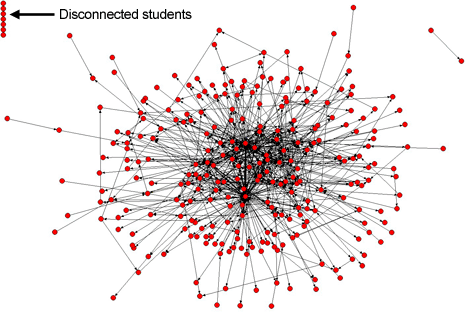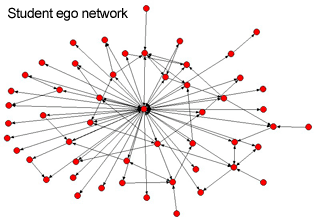Project Information
“Seeing” networks: Visualising and evaluating student learning networks is an Australian Learning and Teaching Council funded project focused towards the development of ICT mediated data visualisation resources.
The project includes both National and International research partners:
- University of Wollongong (Lead)
- RMIT University
- Murdoch University
- University of Queensland
- University of British Columbia (Canada)
About Academic Analytics and Network Visualisation
The concept of ‘academic analytics’ is gaining increasing momentum as a process for providing HEIs with the data necessary to respond to the reportage and decision making challenges facing contemporary universities [1, 17, 18]. Academic analytics involves the extraction of large volumes of data from institutional databases and the application of various statistical techniques in order to identify patterns and correlations [18]. While the practice of data mining has long been utilised in the commercial sector, to date there has been limited interest within the academy [1]. However, the quantity and diversity of data currently accessible to HEIs is now making it possible to exploit more fully the potential of academic analytics in order to inform a range of key activities within the academy, from strategic decision-making to instructor practice. The challenge for HEIs is no longer simply to generate data and make it available, but rather to readily and accurately interpret data and translate such findings to practice.
The widespread adoption of information and communication technologies (ICT) across the HE sector in recent times has provided institutions with additional expansive data sets that capture student learning behaviours through user online interactions. For example, the vast majority of Australian universities have adopted learning management systems (LMS) to support student learning. Increasingly these systems provide the essential infrastructure which mediates student access to learning resources, and facilitates student-student and student-lecturer interaction. Additionally, these systems can provide sophisticated levels of institution-wide data on areas of student demographics, academic performance, learning pathways, user engagement, online behaviour, and development and participation within social networks. These data can also be used to promote practitioner reflection for professional development as well as identifying students who may require additional scaffolding and/or early learning support.
Visualising Networks
Despite the vast volumes of data captured and recorded within these systems, there has been minimal research that investigates how the ‘rubber’ of such analytics can meet the ‘road’ of design, delivery and evaluation of teaching and learning practices [1]. This can be in part attributed to the poor levels of LMS reportage features. The extraction and reporting of LMS data is commonly fragmented, disconnected from the implemented pedagogy and represented with poor visualisation tools that effectively militate against interpretation and subsequent user-action [5]. The reporting of data derived from these LMS can and should be accessed and implemented into the current suite of tools available for teaching staff. This will allow a better understanding of the student cohort learning behaviours, and thus an improved capacity to respond to their immediate learning needs and to assess the impact of enacted learning and teaching activities.
One approach for visualising student learning has been through the adoption of social network methodologies and analysis [3, 9, 10, 14] (Figure 1). For instance, Dawson, McWilliam and Tan [6] examined ego-networks of high and low performing students in a large class setting and noted the establishment of disparate social clusters formed around student academic performance. In essence high performing students predominantly interacted with other high performing students to the exclusion of other individuals (Figure 2). This has direct repercussions on implemented teaching practice. The capacity to monitor how students interact in an online setting affords the opportunity to manipulate network structures in order to promote community, through class sharing of resources and information. A further finding of the social network study was the potential to monitor the level of teaching presence within the student networks. The ability to rapidly visualise the degree of teacher presence within the student network provides an ongoing monitor of where time is best allocated and directed in order to maximise student learning outcomes. This is particularly pertinent when dealing with large class networks. Due to the volume of data required to be synthesized in a large class setting, manual monitoring and analysis is not a feasible option. The development and implementation of an automated process for extraction and visualisation is a sound alternate approach.

Figure 1: Sociogram demonstrating a high level of network complexity. The sociogram also identifies students disconnected from the dominant network. (Student names have been removed)

Figure 2: Sociogram demonstrating an example student ego-network. (Student names have been removed).
A key outcome of a prior ALTC project was the development of social visualisation software based on the extraction of data as a result of student online interactions within commercial LMS [22]. While this beta version allows student network visualization, the open-source software requires further manipulation and development to ensure cross compatibility with the diversity of all LMS adopted in Australia, to simplify the interface for teaching staff to interpret the reports and to automate the installation process. At present the software requires several steps which are beyond the technical expertise of most academic teaching staff. Additionally, further research is required to identify possible predictive indicators of student learning performance. For instance how do different learning styles influence student social networking? What positions within a social network indicate isolation and disconnection? What learning behaviour indicators represent students lacking in networking skills and capacity and how does this influence student academic success?
|

